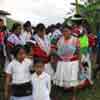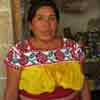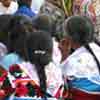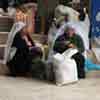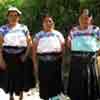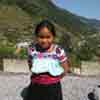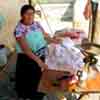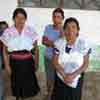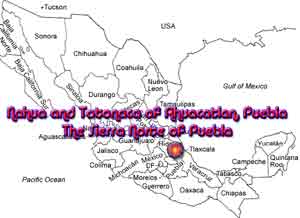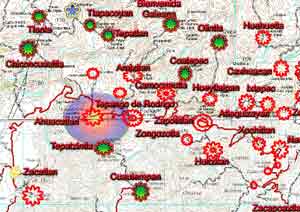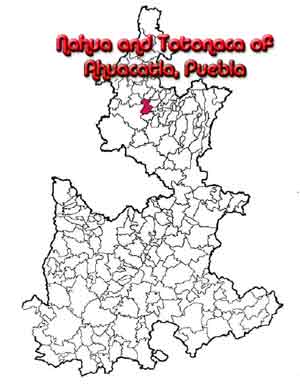 |
 |
 |
 |
|
|||||||||||||||||||||||||||||||||||||||||||||||||
|
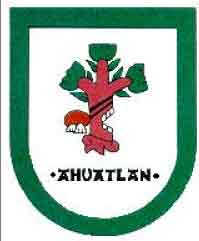 Ahuacatlan is a large musicality with two ethnic groups, the Totonaca and the Nahuatl. Each group dresses distinctly, the most obvious difference is the Nahua wear a black wrap skirt and the Totonacan wear a white skirt. Ahuacatlan is a large musicality with two ethnic groups, the Totonaca and the Nahuatl. Each group dresses distinctly, the most obvious difference is the Nahua wear a black wrap skirt and the Totonacan wear a white skirt. Atempa is a small dispersed Nahua community. In this region traditional dress is still strong. In these photo series young mother used the traditional black skirt, embroidered blouse hand woven belt and reboso. Cuacala is a small dispersed Nahua community located above Ixquihuacan. As we visited the area this young girl came out and was convinced to pose for the study. The older women wear her quechquemitl on her head and a sun shade. Ixquihuacan, Ahuacatlan, Puebla is a Nahua town worth a visit. Traditional dress is still about 50% here. The embroidered blouse is running stitch, cross stitch or French stitch. The back strap woven belts are from Tepezintla. The black skirt is worn below the knee. Pochalcatl is a small community above Ahuacatlan. In the photos you can see the traditional dress in the village and the change that is coming with the younger generations. San Mateo Tlacotepec is a traditional Totonacan town during the town’s festival on 12/13.The festival includes, processions, dancers, mass firework and an unique blessing of the for cardinal points. The four points are important to the Totonaca. Ahuacatlan is a bi cultural municipality located in the Northern Sierra of Puebla, Mexico. The population is approximately 18,000 people. The region is mountainous with a number of mountains of importance including Nepopualco, Ixatipec, Coatepec, Texmoltepec y Cuacornillo. The primary river systems in the region include the Rivers Ajajalpan y Katijit, these rivers are flanked by the mountains called Puxtakinasipi y Yakpapan; the sierra runs northeast between the rivers Maxcape y Amixtlán, which also form Payaputl y Axtziu montains. The area has a number of caves in remote areas and waterfalls. One just outside the town is pictured in the galleries. The Municipality is more or less divided by the trans Serrano highway, it seemed to me that on one side lived the Totonacan and the other the Nahuatl speakers. According to the town officials’ there are more Nahuatl speakers than Totonacan. As you walk through the town both groups can be seen entering stores or going to the market. The difference between the groups is obvious as the Nahuatl women wear a black wrap skirt and the Totonacan women wear a white wrap skirt, the differences in the blouses are more subtle but the Nahuatl women do not seem to wear the hooked embroidery now so popular with the Totonacan women. The Sunday market is larger than most Sierra markets and bring Nahuatl and Totonacan peoples from Amixtlan, Bienvenido Galena, Camocuatla and Tepezintla municipalities. As in many indigenous areas corn, beans, squash are food staples, coffee is a cash crop and the primary income is from immigrants to both Puebla, Mexico City and the US. See my blog for comments about the effect of this immigration on indigenous communities. |
||||||||||||||||||||||||||||||||||||||||||||||||
|
|||||||||||||||||||||||||||||||||||||||||||||||||
